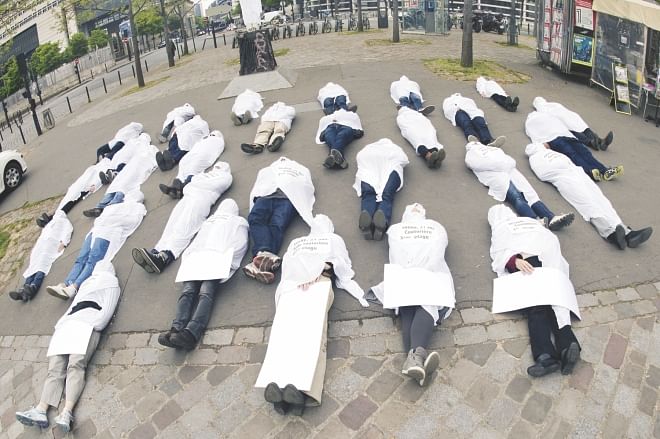Around 57 per cent of the survivors of Rana Plaza—the deadliest industrial disaster in the history of Bangladesh that left over 1,100 dead in 2013—have remained unemployed during the pandemic, a study finds.
In a victory for labour unions, a global clothing brand has agreed to pay $2.3 million to meet fire and building safety regulations in 150 garment factories across its supply chain in Bangladesh, unions say.
At the fourth anniversary of the world’s biggest workplace disaster, Rana Plaza victims and labour activists re-echo demand for punishment of culprits responsible.
Four years into the Rana Plaza disaster that killed around 1,100 people, more than 40 percent survivors remain workless. The fate of the labours has not changed yet as they did not get any compensation and proper rehabilitation, according to a new study.
Around 57 per cent of the survivors of Rana Plaza—the deadliest industrial disaster in the history of Bangladesh that left over 1,100 dead in 2013—have remained unemployed during the pandemic, a study finds.
In a victory for labour unions, a global clothing brand has agreed to pay $2.3 million to meet fire and building safety regulations in 150 garment factories across its supply chain in Bangladesh, unions say.
At the fourth anniversary of the world’s biggest workplace disaster, Rana Plaza victims and labour activists re-echo demand for punishment of culprits responsible.
Four years into the Rana Plaza disaster that killed around 1,100 people, more than 40 percent survivors remain workless. The fate of the labours has not changed yet as they did not get any compensation and proper rehabilitation, according to a new study.
A year on from the April 24, 2013, Rana Plaza factory collapse in Bangladesh, the world's attention largely seems to have shifted away from the problems in the garment industry that were exposed by the tragedy. There has been some tentative progress to improve conditions for workers. But serious challenges remain if the 1,132 deaths in that accident aren't to be in vain, let alone repeated.
...
IT is more than one year now since the horrific Rana Plaza disaster that claimed at least 1,135 lives and left hundreds more missing, wounded or incapacitated. The scale and gravity of the disaster generated a chorus of condemnations from all around the world and mobilised global opinion to revamp and improve building structures and working conditions within the industry. It was a wake-up call!
...
Even a year after the Rana Plaza collapse that left at least 1,135 people killed and scores maimed, police have yet to complete probing the country's worst industrial disaster.
...
 ...
...
The word crisis when written in Chinese is composed of two characters -- one represents danger and the other represents opportunity. The narrative of the country's garment sector following the Rana Plaza collapse last year could best be summed up by it.
...
Salma Begum fumbled in the piles of the debris-strewn disaster site in Savar. A piece of torn cloth here, a rubber slipper there. She looked out. Was it her son's shirt or sandal? She mumbled. Only tears rolled down her cheeks.
...